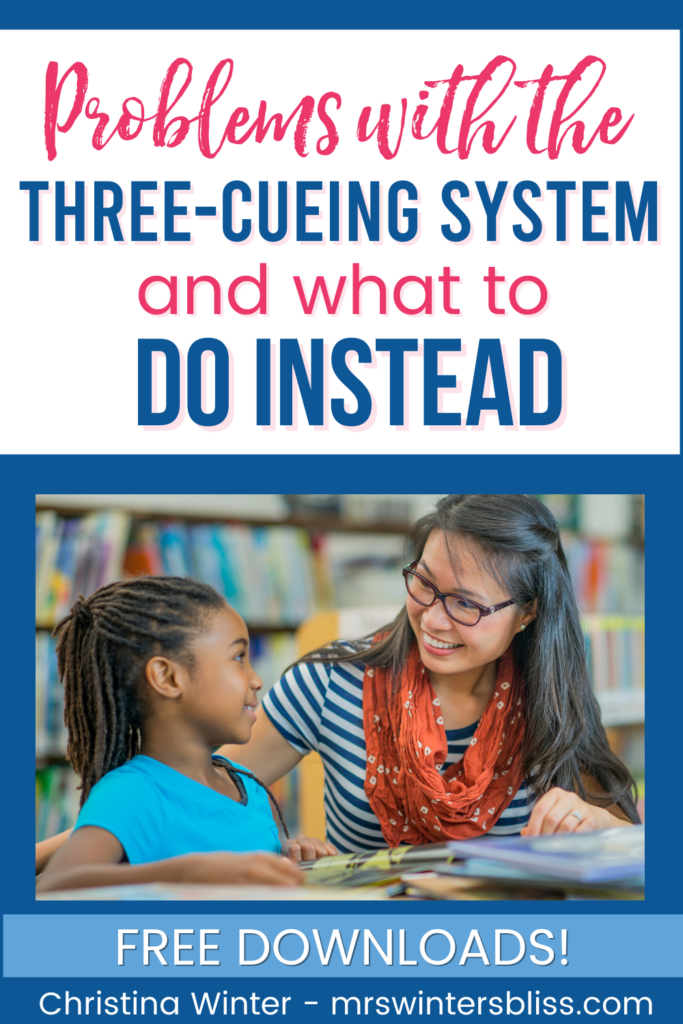
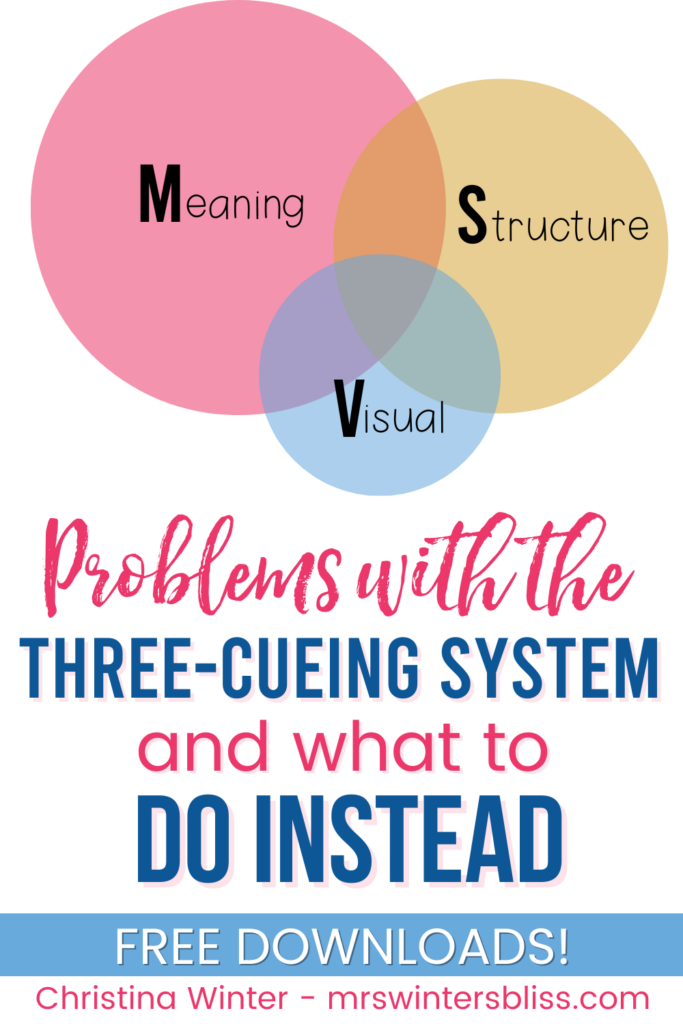
In this blog, I explain three cueing systems, also known as MSV. I discuss why it is an ineffective method and offer research-based tips to help you effectively prompt and teach students how to navigate texts and read unknown words.
“Use the picture and think about what makes sense.“
“Skip the word and go on.”
“Try a word that might make sense.”
Do these statements sound familiar to you? If so, you have probably been taught to use the 3 cueing systems, also known as MSV, to help students navigate texts. It is the method MANY of us have used in our classrooms for many years. We have conducted running records, analyzed students’ miscues, and used that data to provide targeted instruction to our students. This all sounds great, right?! Then why, despite our best efforts and good intentions, do far too many children continue to struggle to learn to read? Might there be a better way?
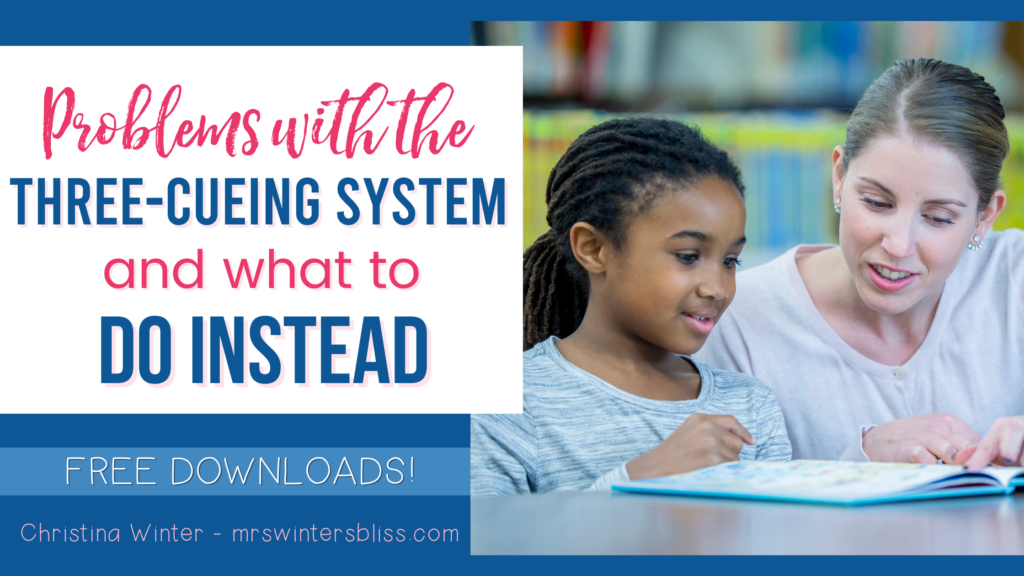
Note: I’ve included Amazon affiliate links in this post. I earn a small commission when you purchase through my link at no additional cost to you.
Yes. The science of reading is showing us there IS a better way. Today I want to talk about the three cueing systems and help you understand its shortcomings. Then I will share science-based tips and reading strategies I have learned through my research on the science of reading, LETRS training, and the books Shifting the Balance and Choosing and Using Decodable Texts. These tips will help you teach all of your students how to successfully navigate texts and solve unknown words.
What are the 3 Cueing Systems?
The three cueing systems (also referred to as MSV) is a model that teaches children to rely on meaning, structure, and then visual information when they attempt to read an unknown word. It is a common instructional method in schools that use a whole language and balanced literacy approach.

In the MSV model, M stands for meaning or the contextual cues students can lean on to figure out an unknown word. This includes background knowledge, picture clues, vocabulary, familiarity with story structure, etc. When a teacher wants a student to attend to a meaning cue, they might ask, “Does the word make sense?” Students are usually prompted to attend to meaning cues first.
The S in the MSV model represents the syntax or structure. It relates to what students know about grammar or word order. When a teacher wants a student to attend to structural cues they may ask, “Does the word sound right in the sentence?”
Finally, V represents visual. This includes letter and letter patterns. To prompt students to look at the visual information, teachers may tell students to get their “mouth ready for the first sound” or ask “Does the word look right?” Of the three cues, visual cues are the last that students rely on. They are used to confirm predictions students make based on meaning and structure.

The books used with the three cueing systems are repetitive, predictable texts that typically include one unknown word per page. Students often end up memorizing the pattern of these books instead of reading the actual words on the page. The books include illustrations so that students can learn to use picture cues, as well as first letters, to identify unknown words.
Why are the Three Cueing Systems Ineffective?
There are a number of problems with the three-cueing system.
First, the three cueing systems (MSV) are not supported by research and evidence. The Science of Reading has proven children need explicit, systematic phonics instruction to learn to read. MSV treats phonics instruction as the last resort. It pulls children’s attention away from the specific sequence of letters in a word and relies far too heavily on meaning to figure out words. The truth is that minimizing the visual cues makes reading MORE difficult for students.

Secondly, context clues will only take you so far in reading. In the book Shifting the Balance, authors Jan Burkins and Kari Yatestells remind us, “Teaching children to rely first and foremost on context for figuring out words is teaching them a process that will eventually fall apart on them.”
The cueing systems do not build the foundation that students need to read at an advanced level. While initial letter and picture clues may work when students are reading simple, patterned books, they are unreliable and bad habits to start and hard habits to break. Students who rely on these strategies struggle dramatically when faced with words in isolation, texts with no pictures, or multisyllabic words.

Finally, the cueing method encourages students to move their eyes all around the page. They may start by looking at the first letter in a word and then immediately shift their eyes to a picture or to another part of the page. Children who learn to read this way may develop difficulty reading words in a normal left-to-right sequence. Their eyes dart erratically around the page, which can lead to comprehension problems.
What Should You Teach Instead of Three Cueing (MSV)?
If the three cueing systems don’t work, how should we teach our students to read? The Science of Reading has proven that with explicit, systematic phonics instruction, every student can develop the knowledge and skills needed to become a good reader.
Here are three researched-based tips that will help all students learn to read:
1. Teach Students to Use Visual Cues First
When students encounter unknown words in a text, they should not be taught to guess. Good readers don’t guess words, they look at the letters. When your students encounter a tricky word in reading, teach them to start with visual cues. They should carefully examine each part of the word, stay focused on the print and blend all the sounds together.
Prompts you can use to help students focus on the print may include:
“Look at the letters first.”
“Look at every letter.”
“Make every sound.“
“Stick with it until the end.”
“Put all of the sounds together.”
After they have decoded the word, then they can examine the meaning and structure to confirm that the word was read correctly. By reinventing the MSV model to V–>MS you are better aligning your instruction to science.
2. Explicitly Teach Students to Reread
After a student thinks they have solved a tricky word, teach them to go back and reread. Rereading helps them to confirm (or change) the word they chose. It also helps to rebuild meaning after the fluency was disrupted when they stopped to solve the tricky word. It allows students to compare the word’s orthography (its spelling) with its phonological structure (its sounds). Finally, it gives them a second look at the challenging word which will help with future automaticity.
3. Use Decodable Texts
A decodable text is a text you use in beginning reading instruction. It can be a book, a passage, or a poem that only includes phonics patterns and high-frequency words that you have already taught your students.
The focus is on developing accurate decoding. There may be some focus on literal comprehension, but the main emphasis is on accuracy and decoding. A decodable text or passage may include pictures. If it does, the picture supports the story, but not specific words in the text.

Decodable texts give students practice applying the skills they have learned to real reading experiences. Children progress at a much faster rate when the majority of time is spent applying skills to authentic reading.
My Decodable Text Resources
I have worked hard to create two separate resources, decodable passages and decodable books that allow students to practice actually reading the words on the page! With these passages and books, students will not attend to meaning and structural cues first. They will not guess at words. Instead, they will apply the phonics skills you have taught, look at every letter in the word and actually read the words in the text.
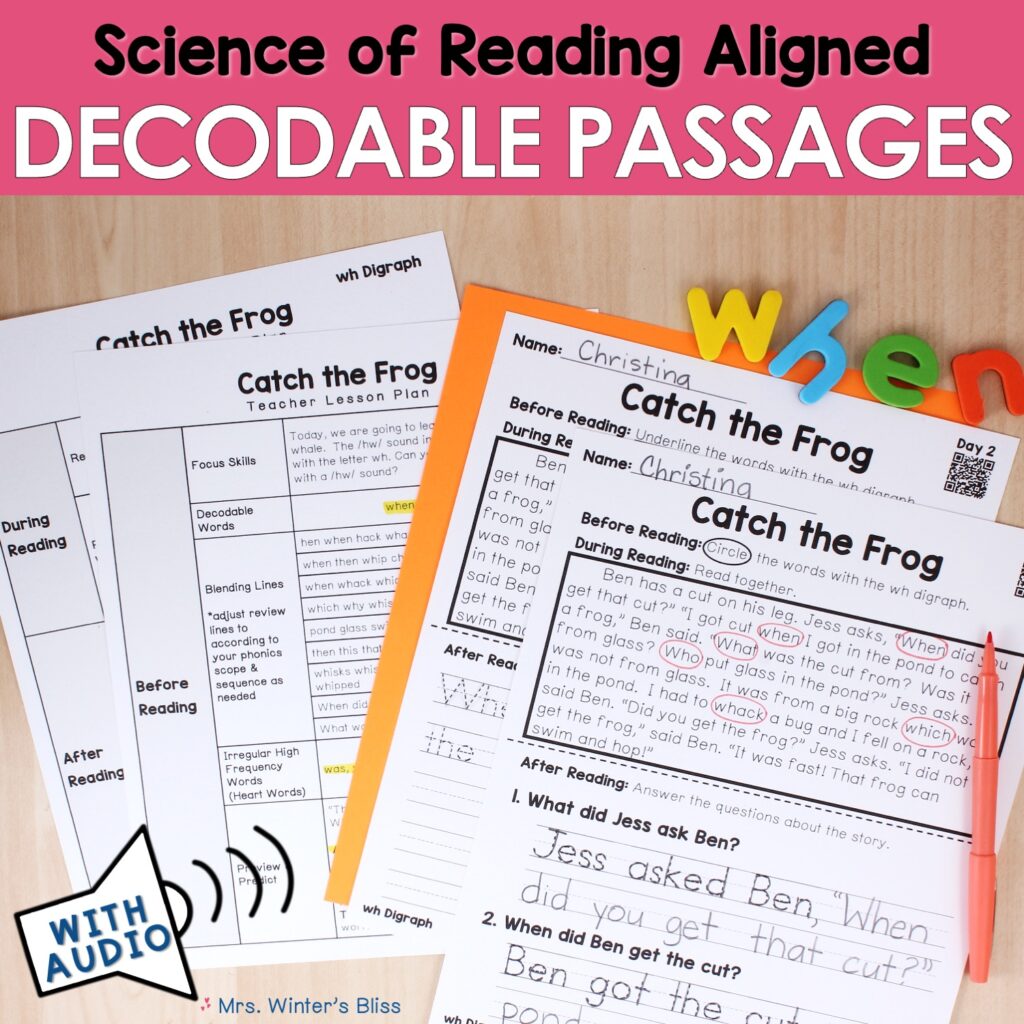
My Decodable Passages with Comprehension Questions bundle and my Decodable Books with Comprehension Questions bundle have EVERYTHING you need to bring decodable text practice to your beginning readers! These passages and books are phonics-based texts. They contain target phonics skill words, previously taught phonics skill words, and irregular high-frequency words. While they focus on the same skills, the texts in the two resources are NOT the same.
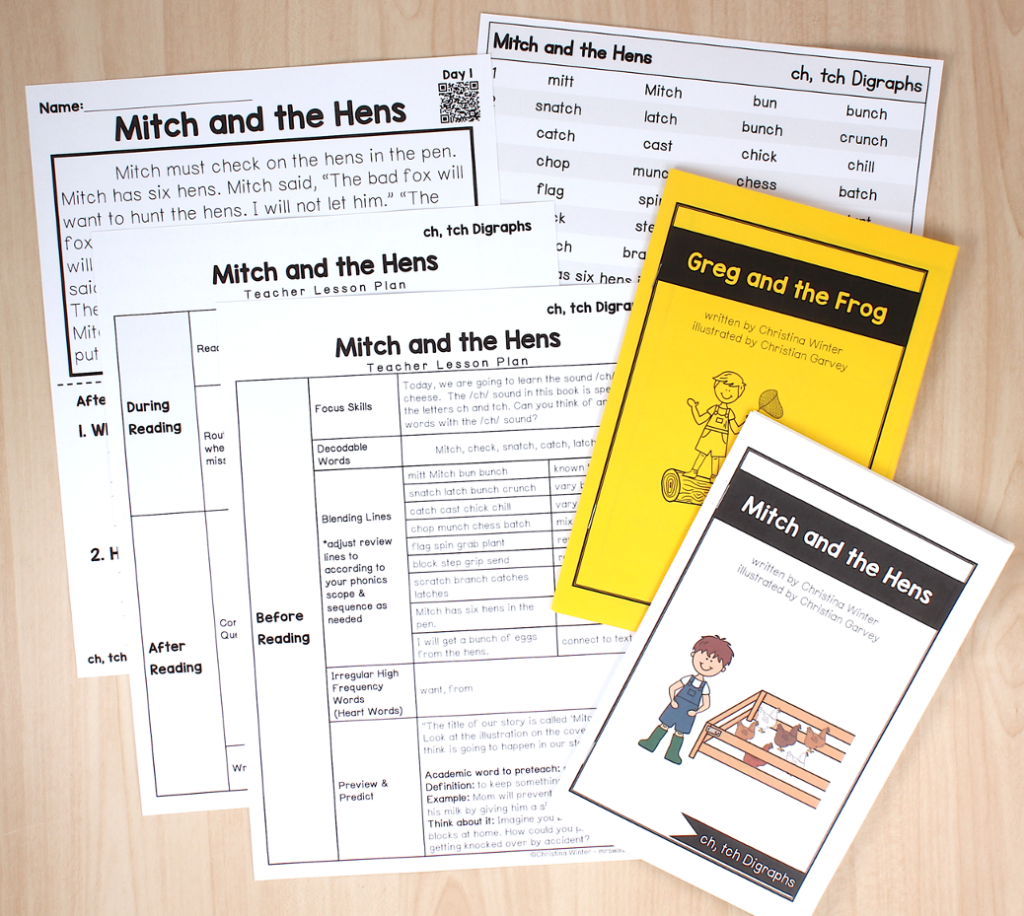
Each resource contains 60 decodable texts (passages or full books)that align with a research-based, systematic phonics scope and sequence (included).
Included with each passage and each book:
💗 explicit lesson plans with suggested pacing
💗 activities for before, during, and after reading
💗 blending lines to practice skills and frontload before reading
💗 written and oral comprehension response questions specific to the passage
💗 audio recording for those students who may need extra support
💗 write and retell story response questions
💗 printable passages give students the opportunity to re-read and build fluency
Finally, these passages and books are engaging and use high-utility words. You won’t find nonsensical language, tongue twisters, or odd names. These stories are authentic!
To help you begin to use decodable texts in your classroom, I am happy to offer these FREE decodable passages and 5 FREE decodable books! You’ll get decodable texts, explicit lesson plans for each passage and/or story, as well as activities for before, during, and after reading you can use to strengthen phonics skills!
-
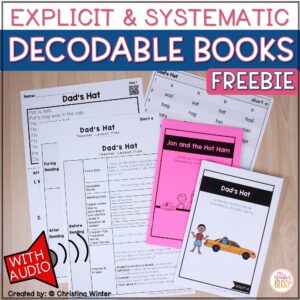 FREE Decodable Books with Comprehension Questions$0.00Rated 4.96 out of 5 based on 24 customer ratings
FREE Decodable Books with Comprehension Questions$0.00Rated 4.96 out of 5 based on 24 customer ratings -
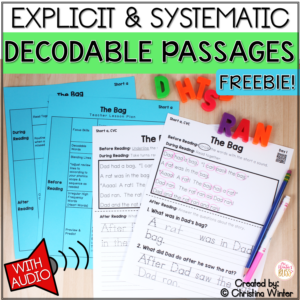 FREE Decodable Passages with Comprehension Questions$0.00Rated 4.98 out of 5 based on 40 customer ratings
FREE Decodable Passages with Comprehension Questions$0.00Rated 4.98 out of 5 based on 40 customer ratings
If you are looking for more options for decodable books, take a look at this blog post. In it, I share a list of high-quality decodable texts for readers of different ages and levels.
As primary teachers, one of our biggest responsibilities is to teach all students to become skilled readers. I hope the information I’ve shared today helps you understand the problems with the three cueing systems and motivates you to bring more effective, research-based instructional strategies to your students and classroom.
-shop this post-
-
Sale Product on sale
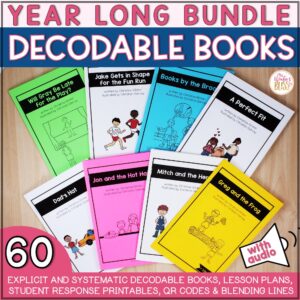 Decodable Books BUNDLE – Comprehension Questions aligned to Science of ReadingEarn 0 Reward Points
Decodable Books BUNDLE – Comprehension Questions aligned to Science of ReadingEarn 0 Reward Points$60.00Original price was: $60.00.$48.00Current price is: $48.00.Rated 5.00 out of 5 based on 6 customer ratings -
 FREE Decodable Books with Comprehension Questions$0.00Rated 4.96 out of 5 based on 24 customer ratings
FREE Decodable Books with Comprehension Questions$0.00Rated 4.96 out of 5 based on 24 customer ratings -
 FREE Decodable Passages with Comprehension Questions$0.00Rated 4.98 out of 5 based on 40 customer ratings
FREE Decodable Passages with Comprehension Questions$0.00Rated 4.98 out of 5 based on 40 customer ratings -
Sale Product on sale
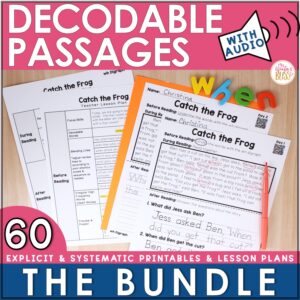 Decodable Passages with Comprehension Questions – BundleEarn 0 Reward Points
Decodable Passages with Comprehension Questions – BundleEarn 0 Reward Points$38.25Original price was: $38.25.$30.60Current price is: $30.60.Rated 5.00 out of 5 based on 11 customer ratings









